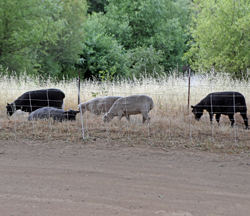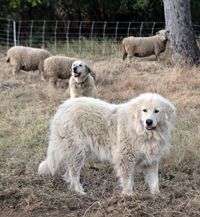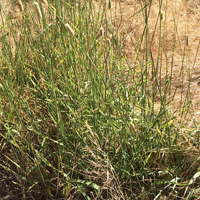Sheep vs. Wildfires
 It’s a little-known fact that most of the “golden” grasses that cover California are invasive species from Europe. You know, the dry stuff that ignites like a matchbox on a hot day, the stuff that plays a big role in spreading the recent wildfires. That “golden” stuff wasn’t here a few hundred years ago, before Europeans brought it in.
It’s a little-known fact that most of the “golden” grasses that cover California are invasive species from Europe. You know, the dry stuff that ignites like a matchbox on a hot day, the stuff that plays a big role in spreading the recent wildfires. That “golden” stuff wasn’t here a few hundred years ago, before Europeans brought it in.
So, what WAS here? More perennials. Those are the bunch grasses that set a deep root and survive from one year to the next, unlike annuals that die each  year and regrow from seedlings in the winter, then become a golden fire hazard in the summer.
year and regrow from seedlings in the winter, then become a golden fire hazard in the summer.
To combat the fire danger of dry grass, we dispatch our sheep and their canine guardians across the ranch in the summer. And it is pretty obvious why sheep are a better choice for removing grass than fire or even mowing: Sheep each consume 5 pounds of dry matter per day and fertilize the carbon back into the soil, unlike gas mowers that put 20 pounds of CO2 into the atmosphere for each gallon of fuel they burn!
But the sheep have another advantage in the fight against wildfires. You see, the perennial grasses are more like trees. They stay green longer (some all year!), grow larger, and set deeper root systems. But they have an Achilles heel: Perennial grasses are killed by both overgrazing or under-grazing.
 That’s not a problem in an untouched grassland, where native grazers (like deer, bison or elk) move in large herds and stay packed together for safety against predators. There, the native grasses get an occasional haircut as the grazers move through, then a period of rest to recover before the herd returns.
That’s not a problem in an untouched grassland, where native grazers (like deer, bison or elk) move in large herds and stay packed together for safety against predators. There, the native grasses get an occasional haircut as the grazers move through, then a period of rest to recover before the herd returns.
But as settlers have displaced the native grazers, the perennial grasses have missed their haircuts. This means they choke on excess dry matter from previous years, and they get outperformed by the European invasive annuals. Or settlers have displaced the natural predators and replaced the native grazers with constantly-grazing cattle or sheep, which overgraze to the point of death by eliminating the rest period the grass bunches need to recover.
So here at the ranch, we use temporary fences to keep sheep moving and emulating the natural grazing patterns. This alleviates fire danger in the short term, by eliminating the invasive “golden” stuff in a given season, but the sheep also slowly relieve the root of the problem (pun intended) as they stimulate the return of native California perennial grasses to the landscape. Look for sheep and for the gradual increase in bunch grasses on your next visit to the ranch!
Christian Ahlmann
4 thoughts on “Sheep vs. Wildfires”
Christian September 8, 2021 at 9:07 am
Chuck,
You asked (a few years ago!) if we have lodging. Circling back to that, we will soon! We are now building a “glamping resort,” some really nice tents set up like hotel rooms. We plan for the resort to open next spring!
Christian
↓david tu May 12, 2019 at 9:24 pm
Thank you so much for having the mtb races at your place this weekend!
↓Jeff Murphy September 9, 2021 at 6:18 pm
Well done! California needs more ranchers like you. And Kansas!
↓


Fascinating! Sounds like you folks have been doing a stellar job of rejuvenating a valuable area. Great history. I live in Soda Bay and have heard and read much about Six Sigma. Been wanting to visit, but just haven’t carved out the time. It’s a bit of a drive. I’m determined, however, to make it there soon. Do you have any lodging? It would be fun to have a reason to get my wife away from her desk for a spell. Anyway, hope you’re making progress with the perennial grasses. — Chuck Sturges, Soda bay, Kelseyville
↓